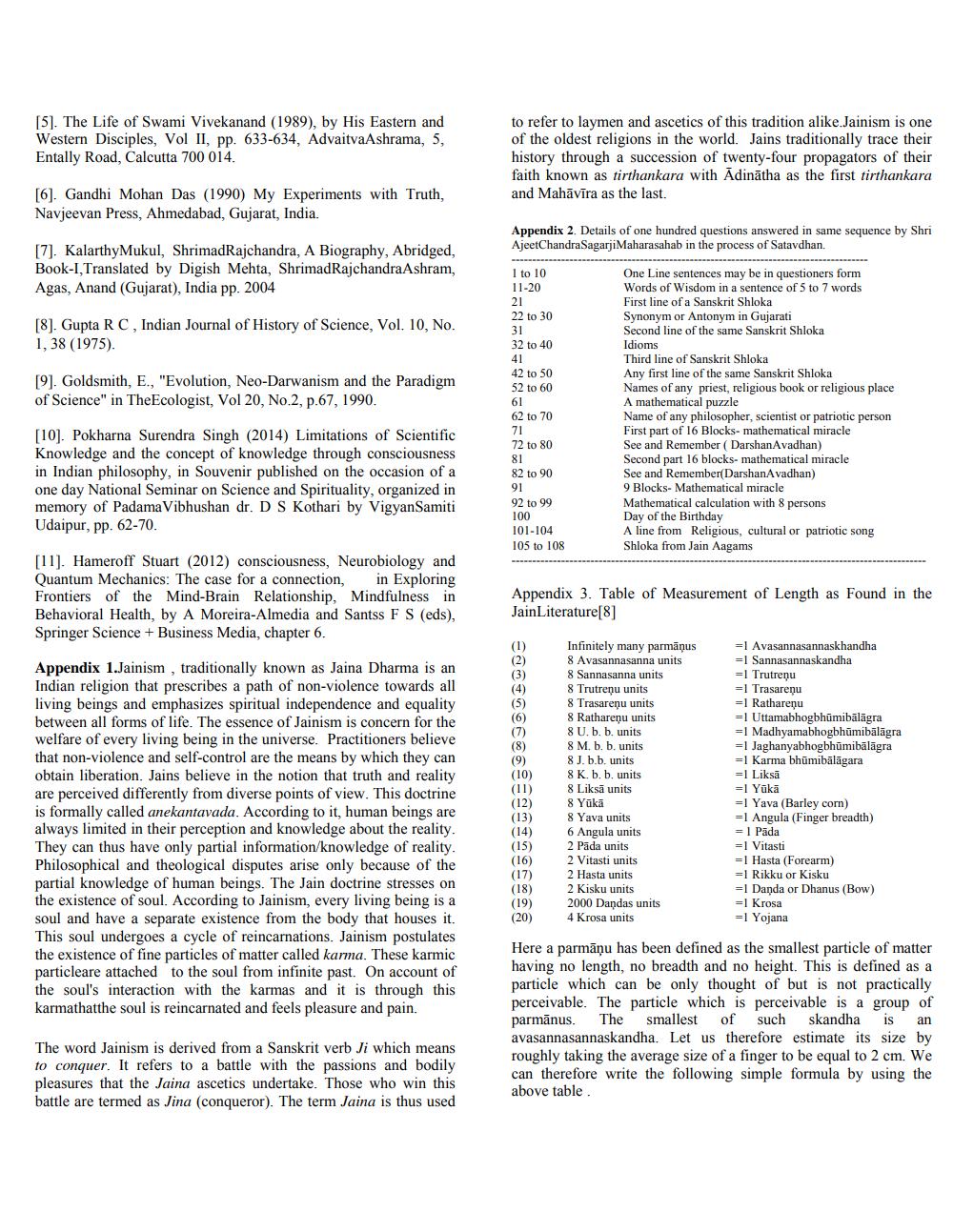Book Title: Quantum Field Theory like model of consciousness in Jainism Author(s): Surendra Singh Pokharna Publisher: Surendra Singh Pokharna View full book textPage 5
________________ [5]. The Life of Swami Vivekanand (1989), by His Eastern and Western Disciples, Vol II, pp. 633-634, Advaitva Ashrama, 5, Entally Road, Calcutta 700 014. to refer to laymen and ascetics of this tradition alike.Jainism is one of the oldest religions in the world. Jains traditionally trace their history through a succession of twenty-four propagators of their faith known as tirthankara with Adinātha as the first tirthankara and Mahāvīra as the last. [6]. Gandhi Mohan Das (1990) My Experiments with Truth, Navjeevan Press, Ahmedabad, Gujarat, India. Appendix 2. Details of one hundred questions answered in same sequence by Shri AjeetChandraSagarji Maharasahab in the process of Satavdhan. [7]. Kalarthy Mukul, ShrimadRajchandra, A Biography, Abridged, Book-I, Translated by Digish Mehta, ShrimadRajchandra Ashram, Agas, Anand (Gujarat), India pp. 2004 1 to 10 11-20 22 to 30 [8]. Gupta RC, Indian Journal of History of Science, Vol. 10, No. 1, 38 (1975). 32 to 40 [9]. Goldsmith, E., "Evolution, Neo-Darwanism and the Paradigm of Science" in TheEcologist, Vol 20, No.2, p.67, 1990. 42 to 50 52 to 60 62 to 70 One Line sentences may be in questioners form Words of Wisdom in a sentence of 5 to 7 words First line of a Sanskrit Shloka Synonym or Antonym in Gujarati Second line of the same Sanskrit Shloka Idioms Third line of Sanskrit Shloka Any first line of the same Sanskrit Shloka Names of any priest, religious book or religious place A mathematical puzzle Name of any philosopher, scientist or patriotic person First part of 16 Blocks-mathematical miracle See and Remember (DarshanAvadhan) Second part 16 blocks-mathematical miracle See and Remember(DarshanAvadhan) 9 Blocks- Mathematical miracle Mathematical calculation with 8 persons Day of the Birthday A line from Religious, cultural or patriotic song Shloka from Jain Aagams 72 to 80 [10). Pokharna Surendra Singh (2014) Limitations of Scientific Knowledge and the concept of knowledge through consciousness in Indian philosophy, in Souvenir published on the occasion of a one day National Seminar on Science and Spirituality, organized in memory of Padama Vibhushan dr. DS Kothari by VigyanSamiti Udaipur, pp. 62-70. 82 to 90 91 92 to 99 100 101-104 105 to 108 [11]. Hameroff Stuart (2012) consciousness, Neurobiology and Quantum Mechanics: The case for a connection, in Exploring Frontiers of the Mind-Brain Relationship, Mindfulness in Behavioral Health, by A Moreira-Almedia and Santss F S (eds), Springer Science + Business Media, chapter 6. Appendix 3. Table of Measurement of Length as Found in the JainLiterature[8] (9) Appendix 1.Jainism, traditionally known as Jaina Dharma is an Indian religion that prescribes a path of non-violence towards all living beings and emphasizes spiritual independence and equality between all forms of life. The essence of Jainism is concern for the welfare of every living being in the universe. Practitioners believe that non-violence and self-control are the means by which they can obtain liberation. Jains believe in the notion that truth and reality are perceived differently from diverse points of view. This doctrine is formally called anekantavada. According to it, human beings are always limited in their perception and knowledge about the reality. They can thus have only partial information/knowledge of reality. Philosophical and theological disputes arise only because of the partial knowledge of human beings. The Jain doctrine stresses on the existence of soul. According to Jainism, every living being is a soul and have a separate existence from the body that houses it. This soul undergoes a cycle of reincarnations. Jainism postulates the existence of fine particles of matter called karma. These karmic particleare attached to the soul from infinite past. On account of the soul's interaction with the karmas and it is through this karmathatthe soul is reincarnated and feels pleasure and pain. (10) (11) (12) (13) (14) (15) Infinitely many parmāņus 8 Avasannasanna units 8 Sannasanna units 8 Trutrenu units 8 Trasarenu units 8 Ratharenu units 8 U. b. b. units 8 M. b. b. units 8 J. b.b. units 8 Kb. b. units 8 Liksā units 8 Yükā 8 Yava units 6 Angula units 2 Pāda units 2 Vitasti units 2 Hasta units 2 Kisku units 2000 Dandas units 4 Krosa units =1 Avasannasannaskhandha =1 Sannasannaskandha =1 Trutrenu =1 Trasarenu =1 Ratharenu =1 Uttamabhogbhūmibālāgra =1 Madhyamabhogbhūmibālāgra =1 Jaghanyabhogbhūmibālāgra =1 Karma bhūmibālāgara =1 Liksā =l Yükā =1 Yava (Barley corn) =1 Angula (Finger breadth) = 1 Pāda =1 Vitasti = 1 Hasta (Forearm) =1 Rikku or Kisku =1 Danda or Dhanus (Bow) =1 Krosa =1 Yojana (16) (18) (19) (20) Here a parmāņu has been defined as the smallest particle of matter having no length, no breadth and no height. This is defined as a particle which can be only thought of but is not practically perceivable. The particle which is perceivable is a group of parmānus. The smallest of such skandha is an avasannasannaskandha. Let us therefore estimate its size by roughly taking the average size of a finger to be equal to 2 cm. We can therefore write the following simple formula by using the above table The word Jainism is derived from a Sanskrit verb Ji which means to conquer. It refers to a battle with the passions and bodily pleasures that the Jaina ascetics undertake. Those who win this battle are termed as Jina (conqueror). The term Jaina is thus usedPage Navigation
1 ... 3 4 5 6
